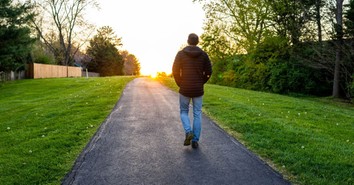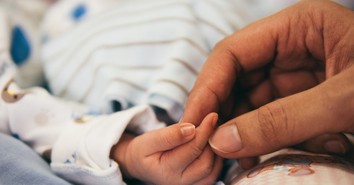American Faith Is a Religious Labyrinth

The meditation labyrinth that "spiritual seekers" walk at Westminster Presbyterian Church in Dayton, Ohio, is more than a peaceful place. The labyrinth is also a fitting metaphor for the multiple paths of religious diversity more and more Americans follow.
"The labyrinth can be whatever you want it to be," said John Neely, the minister of music at Westminster Presbyterian.
Even as the church labyrinth branches to and fro, with Protestants, Catholics and even non-Christian occupying different paths of the same mazelike design, a new Pew Forum on Religion & Public Life study shows that Americans engage in multiple religious practices that mix elements of assorted traditions.
According to the study, worshipers say they attend services of one faith or denomination, but many also combine elements of Christianity with Eastern or New Age beliefs. Many people found astrology, reincarnation and the existence of spiritual energy in physical objects all compatible with their Christian beliefs. Sizeable minorities of U.S. religious groups claim to have experienced supernatural phenomena, such as being in touch with the dead.
The Dayton church labyrinth, based on a 5,000-year-old tool for prayer and meditation, is an example of a mainline church reaching out to a blended community by offering a cross-denominational experience.
"It's not Methodist. It's not Episcopalian. It's all through all denominations," Neely said, adding that non-Christians undoubtedly use the labyrinth as well.
Labyrinths can exist as anything from large grass walkways to handheld ornaments, all working to "activate and facilitate the transformation of the human spirit," according to The Labyrinth Society, based in Trumansburg, N.Y.
The vague definition fits with the findings of the Pew study: Americans are becoming more spiritually inclusive and open to religious experimentation.
This experimentation can be wherever you want it as well. The study showed that one-third of Americans (35 percent) say they regularly (9 percent) or occasionally (26 percent) attend religious services at more than one place. And most of these (24 percent of the general public) say they sometimes attend religious services of a faith different from their own.
Among those who attend religious services at least once a week, nearly 4 in 10 (39 percent) attend at multiple places, while nearly 3 in 10 (28 percent) attend services outside their own faith.
That American religion no longer fits into conventional categories does not surprise Ennis B. Edmonds, associate professor of Religious Studies at Kenyon College.
"This type of borrowing is new for Americans, but African religions are based on borrowing," Edmonds said. "Even looking at popular culture, there is this thinking of a spirit of beauty in the world, so any Hollywood person who is an expression of beauty is viewed as being related to that spirit."
What specifically has prompted the recent mixing of spiritual messages in America? Edmonds notes two factors.
"One, there is a certain plurality of religion to which people are now exposed. People know more and so they are more interested in those things," Edmonds said, adding that the Internet has been a catalyst to greater availability of information.
"Two, people are disillusioned by what they called ‘organized religion,'" he said. "There are these rules and structure they have to deal with. But even with the rise of New Age (thinking) and pluralism, people still have a need to be religious."
To Edmond's mind, no one is really rejecting religion. On the contrary, he says that "people need to be connected to a higher power in the universe. It's just that they don't want to be tied down in the traditional sense of religion, so you find different types of religion and people being open to experimentation."
Edmonds said such experimentation actually is part of the DNA of America.
"We invented (many) denominations. Now it's the same thing. We have this buffet approach to religion. The difference is that 100 years ago how many items were in the supermarket? How many religious options were there?"
The variety has indeed increased. The Pew study found that:
- Roughly one-quarter of adults express belief in tenets of certain Eastern religions; 24 percent say they believe in reincarnation, while 23 percent believe in yoga not just as exercise but as a spiritual practice.
- New Age thinking also is prevalent, with 26 percent saying they believe in spiritual energy located in things such as trees, mountains and crystals. And 25 percent believe in astrology. A smaller number (16 percent) believe in the "evil eye," that certain people can cast curses or spells that bring pain of suffering upon others.
Compared with other religious traditions, white evangelical Protestants consistently express lower levels of acceptance of both Eastern and New Age beliefs, the study found. Roughly 1 in 10 white evangelicals believes in reincarnation, compared with 24 percent among mainline Protestants, 25 percent among both white Catholics and those unaffiliated with any religion, and 29 percent among black Protestants.
Similarly, 13 percent of white evangelicals believe in astrology, compared with roughly one-quarter or more among other religious traditions. There are few differences among religious traditions in belief in the ability to cast spells and call down curses, though black Protestants do stand out (32 percent).
Edmonds thinks the long-term impact of such new extremes of belief will likely be minimal.
"My own feeling is that if you read the history of religion you have these things swing back and forth," he said. "People might swing toward experimentation, then toward a confessional posture, so who knows? We take something and run with it to the radical extreme, then try to moderate and come back.
"Think about the type of popular Christianity that is in vogue today, the rise of the independent churches and the kind of music and experiences we try to create in our churches. A lot of it is geared to reaching certain emotional or spiritual heights, rather than arguing about the right (theology) or the right interpretation of things. Everybody wants to be a community church."
The study of 4,013 adults was conducted Aug. 11-27. The margin of error is plus/minus 2 percentage points.
*This article published December 21, 2009.
Originally published December 21, 2009.




